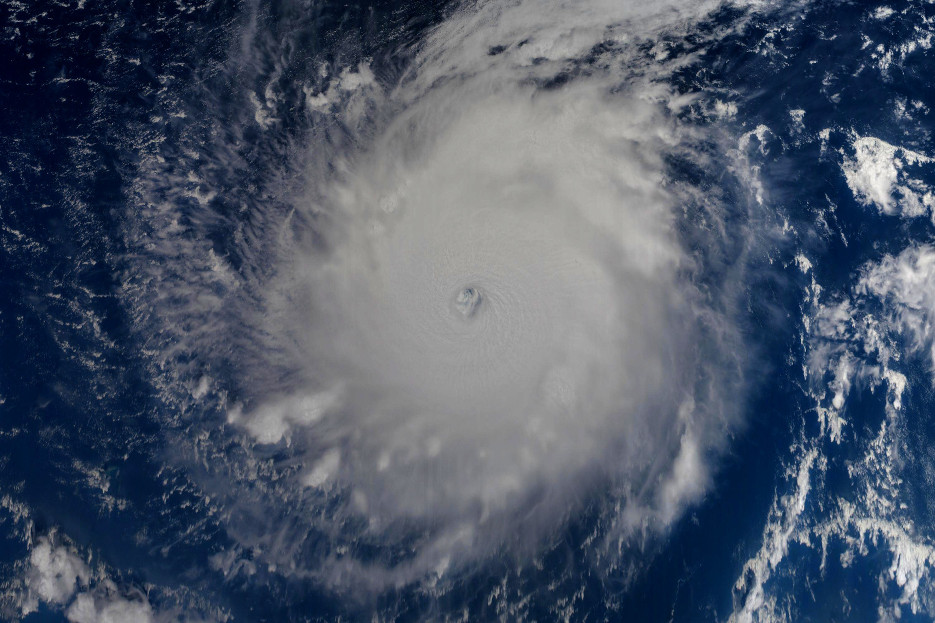One of the precursor projects for Tropical Weather Analytics’ Hurricane Hunter Satellites was the CyMISS (Tropical Cyclone intensity Measurements from the ISS) project which ran from 2014 to 2019. Funded by a series of grants from CASIS (Center for the Advancement of Science in Space) which manages the ISS US National Laboratory for NASA, CyMISS was performed by the science team at Visidyne (the corporate antecedent of Tropical Weather Analytics) for NASA’s Tropical Cyclone Experiment as part of NASA’s CEO (Crew Earth Observations) activities on the International Space Station. The goal of CyMISS was to acquire image sequences of intense tropical cyclones (TCs), such as hurricanes and typhoons, from the ISS using a specially designed photography protocol (see “The Cyclone Intensity Measurements from the ISS (CyMISS)”) to support the development of stereographic imaging techniques of these destructive storms. These techniques will allow the altitudes of the cloud tops near the eye of TCs to be precisely determined so that these TCs can be more accurately characterized compared to existing remote sensing methods (see “Using the Carnot Engine Model to Characterize Hurricanes from Orbit”)
During the course of this five-year project, the CyMISS science team (which is now the TWA science team) amassed a large collection of storm images that we wish to share. One of the TCs observed in support of CyMISS by the crew of ISS Expedition 53 in 2017 was Hurricane Irma. Because of the phasing of this storm’s movements in early September 2017 and the orbit of the ISS, we were able to image Irma on three different days as it moved across the Atlantic – September 5, 7, and 10.
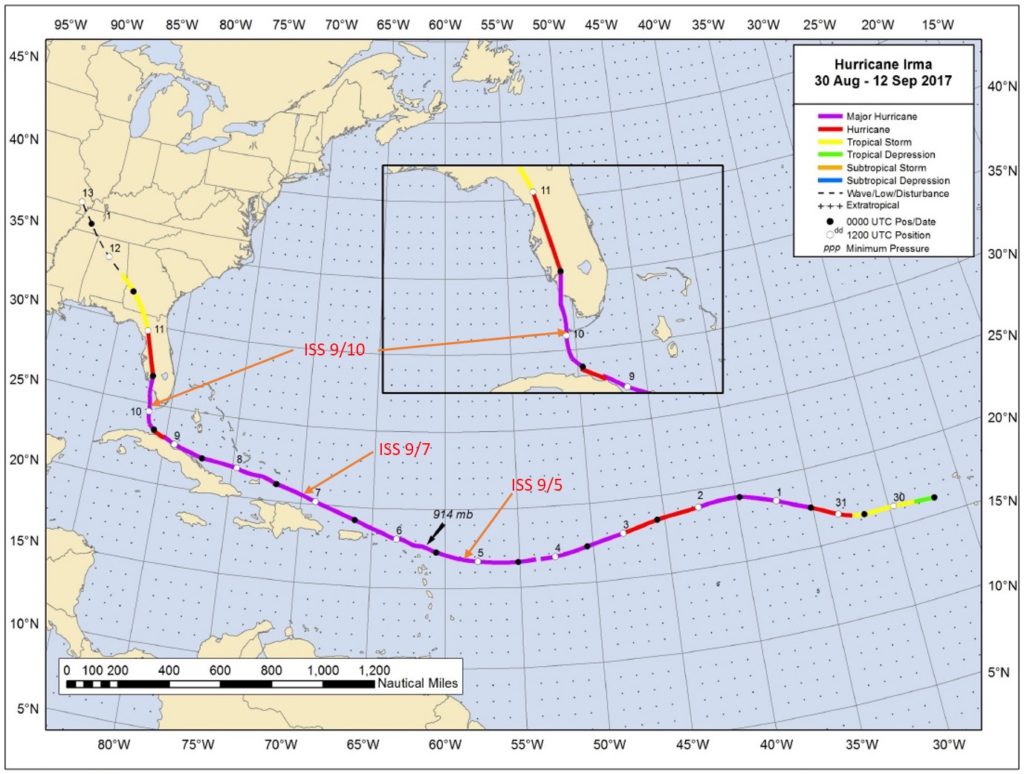
September 5, 2017
For our first observation opportunity of Hurricane Irma, the crew of the ISS secured a sequence of 384 images during a 6½-minute session which started at 15:08:00 on September 5 (see “ISS Daily Summary Report – 9/5/2017”). At this time, the eye of Hurricane Irma was located at 16.8° N, 58.4° W about 300 kilometers east of the Caribbean’s Leeward Islands. With sustained winds of 290 kph (180 mph), Irma was an intense Category 5 hurricane on the Saffir–Simpson scale. A synoptic 3D view created from a mosaic of ISS photographs taken that day is shown below. In order to create the anaglyphic 3D image (left eye red, right eye blue) shown below, the individual photographs from the original image sequence were remapped to approximate an overhead view before various parts of the frames were stitched together into a synoptic 3D mosaic covering an area of approximately 2,200 by 1,200 kilometers. A high resolution version of this synoptic 3D mosaic with an image scale of ~1,100 meters/pixel can be viewed by clicking on the image below.
![]()
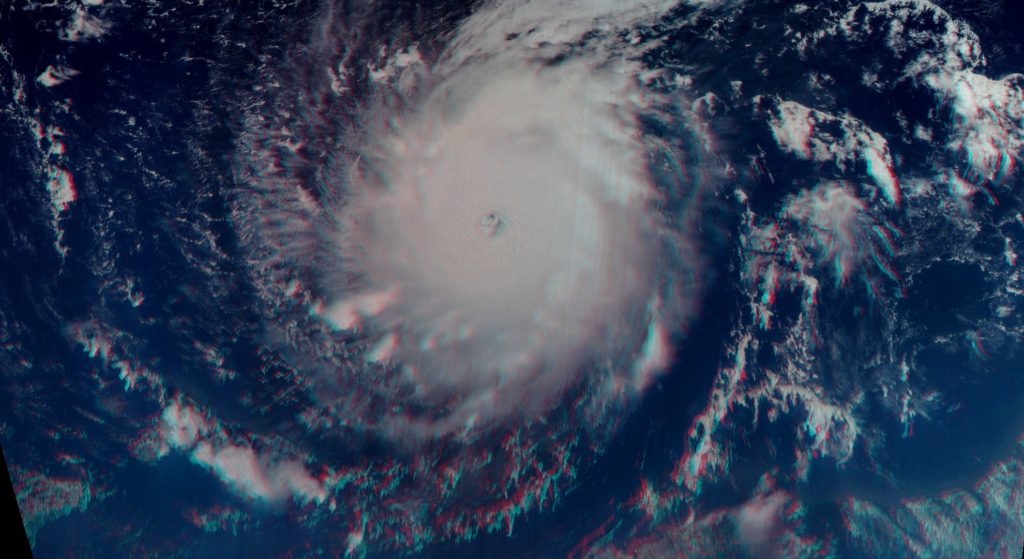
The close up 3D image shown below was created using a pair of close up photographs of the 45-kilometer eye of Hurricane Irma taken a few seconds apart around 15:11:19 GMT. Only the red channel of the original color images was used in order to cut through any atmospheric haze and maximize the visibility of the cloud features. These images were remapped to approximate an overhead view before being combined to create an anaglyphic 3D image. The resulting stereo view, which can be seen at full size with a scale of 100 meters/pixel by clicking on the image below, covers an area of 225 by 150 kilometers. It clearly reveals the structure in and around the eye of Irma including deep into its eye toward sea level.
![]()
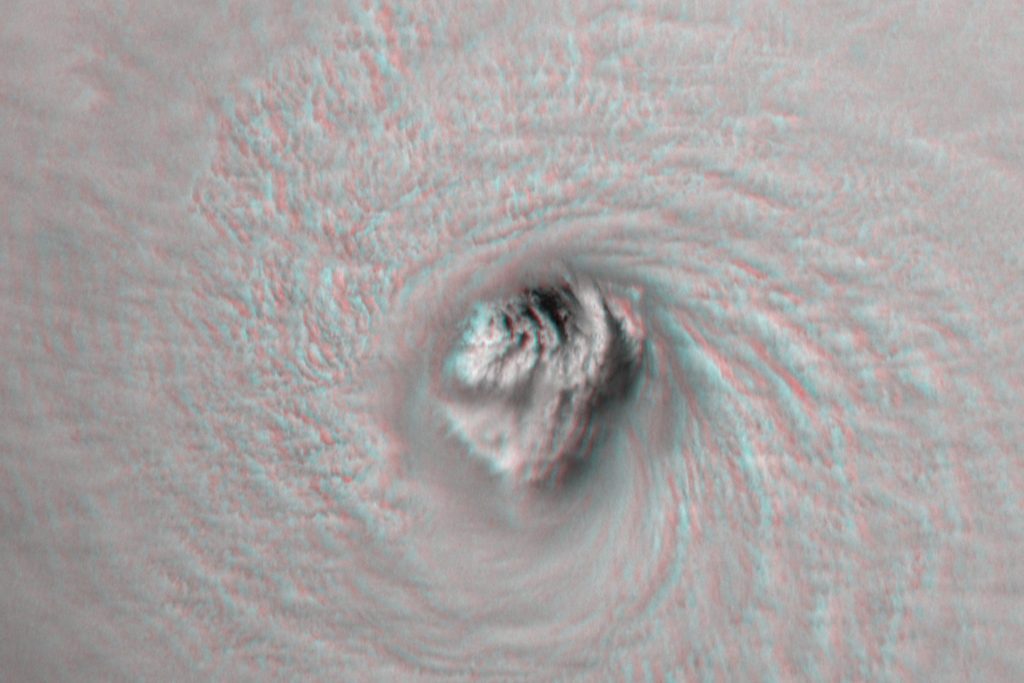
September 7, 2017
During the day following our first observations of Hurricane Irma, the storm continued moving to the west-northwest reaching its peak intensity at about 06:00 GMT on September 6 with a central pressure low of 914 hPa tying for 7th place as the most intense Atlantic hurricane to make landfall to this day. With sustained winds of 298 kph (185 mph), the storm hit the islands of Barbuda, St. Martin, Virgin Gorda, and the British Virgin Islands in quick succession. For our second observation of Hurricane Irma, the crew of the ISS acquired 388 images during a 6½-minute photography session which started at 14:58:00 GMT on September 7 (see “ISS Daily Summary Report: 9/7/2017”). At this time, the eye of the storm was located at 20.4° N, 69.7° W about 85 kilometers north of the coast of Hispaniola. With sustained winds of 282 kph (175 mph), Irma had weakened but was still a potent Category 5 hurricane.
A synoptic 3D view created from a mosaic of ISS photographs taken on September 7 is shown below. In order to create the anaglyphic 3D image (left eye red, right eye blue) shown below, the individual photographs from the original image sequence were remapped to approximate an overhead view before various parts of the frames were combined into a synoptic 3D mosaic covering an area of approximately 2,500 by 1,200 kilometers. This view stretches from the eastern tip of Cuba in the upper left to the northern coast of South America to the right. A high resolution version of this synoptic 3D mosaic with an image scale of ~1,000 meters/pixel can be viewed by clicking on the image below.
![]()
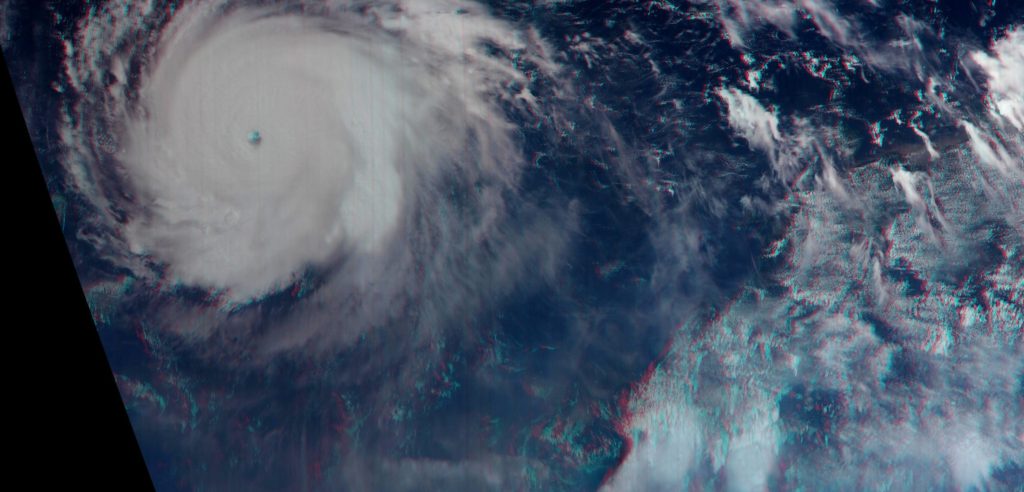
The close up 3D image shown below was created using a pair of close up photographs of the 45-kilometer eye of Hurricane Irma taken a few seconds apart around 15:00:46 GMT. As before, only the red channel of the original color images was used in order to cut through any atmospheric haze and maximize the visibility of the cloud features. These images were remapped to approximate an overhead view before being combined to create an anaglyphic 3D image. The resulting stereo view, which can be seen at full size with a scale of 115 meters/pixel by clicking on the image below, covers an area of 225 by 150 kilometers. This view of the eye clearly reveals details deep into the eye of this storm.
![]()
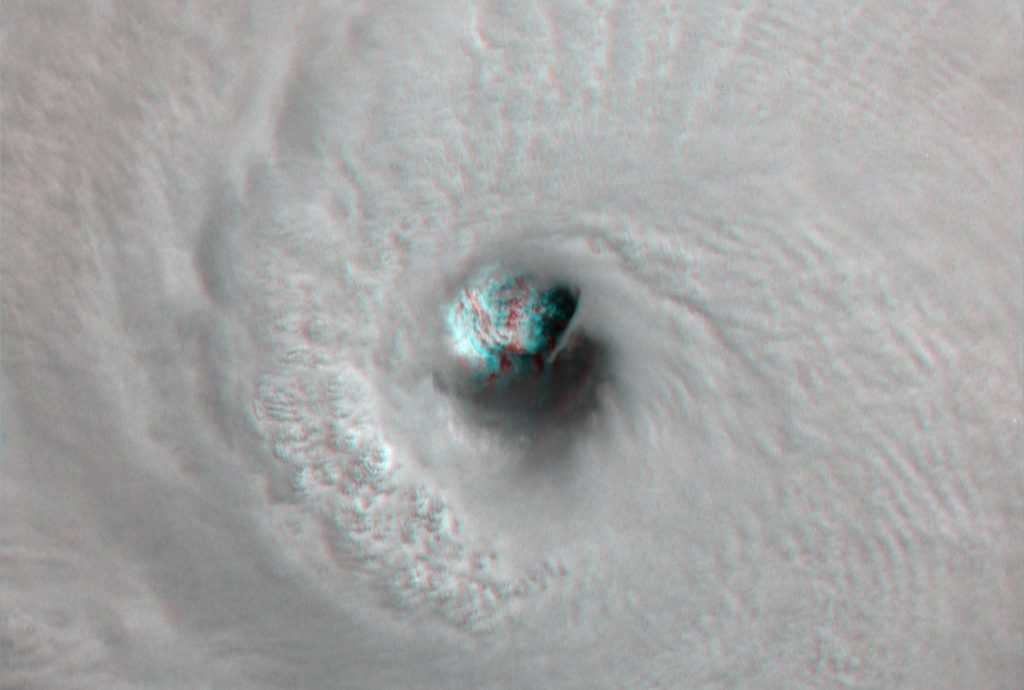
September 10, 2017
Over the next three days, Hurricane Irma skirted past Hispaniola, through the Bahamas, and along the north coast of Cuba as it slowed and turned north towards Florida. During this time, Irma slowly became less intense weakening to Category 3 hurricane before turning north away from Cuba. Our final observation session of Hurricane Irma started at 13:54:00 GMT on September 10 with the eye of the storm located at 24.8° N, 81.5° W directly over Key West. Sustained winds at the eye of the storm were clocked at 209 kph (130 mph) making it a strong Category 3 hurricane. The crew of the ISS acquired 578 images during an extended 9½-minute observation session (over twice the length of our nominal 4-minute, 240-image sessions). These color images were assembled into a 4,400-kilometer long mosaic, shown below, which stretches from Louisiana on the left, across Hurricane Irma at Florida, and down the Caribbean islands to the northern coast of South America.

A synoptic 3D view created from a mosaic of ISS photographs taken on September 10 centered on Irma is shown below. In order to create the anaglyphic 3D image (left eye red, right eye blue) shown below, the individual photographs from the original image sequence were remapped to approximate an overhead view before various parts of the frames were combined into a synoptic 3D mosaic covering an area of approximately 2,000 by 1,200 kilometers. A high resolution version of this synoptic 3D mosaic with an image scale of ~1,000 meters/pixel can be viewed by clicking on the image below.
![]()
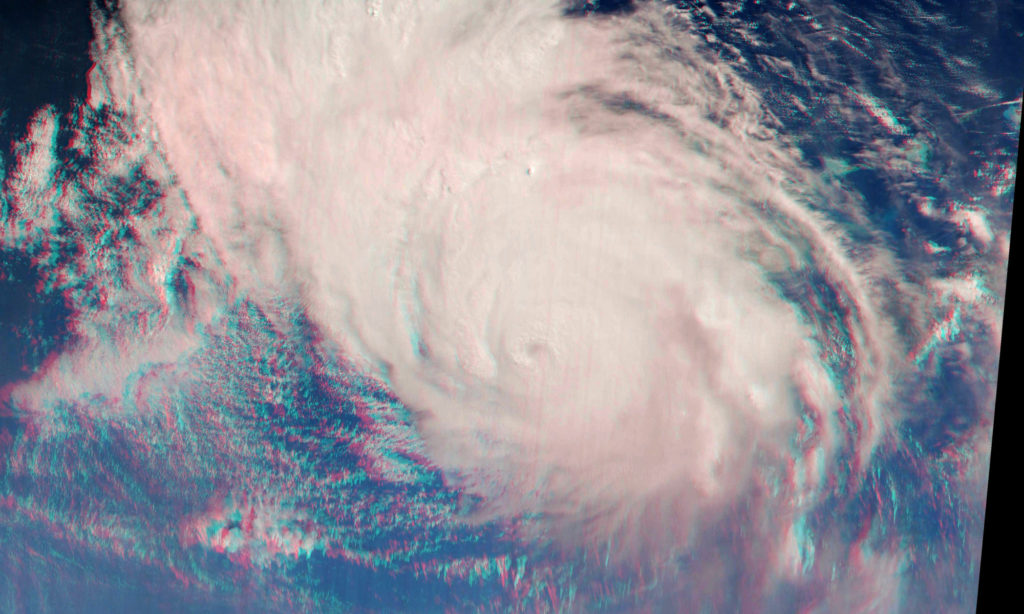
As can be seen, Hurricane Irma was now much less organized than it appeared during the imaging sessions on September 5 and 7 as a result of its interaction with Hispaniola and especially Cuba. A 2D closeup view of the eye of Irma shown below reveals much more subdued structure without a cloud-free view in the center. Hurricane Irma would continue up the Gulf Coast of Florida and continue to weaken steadily to a tropical storm as it hit the southern United States.
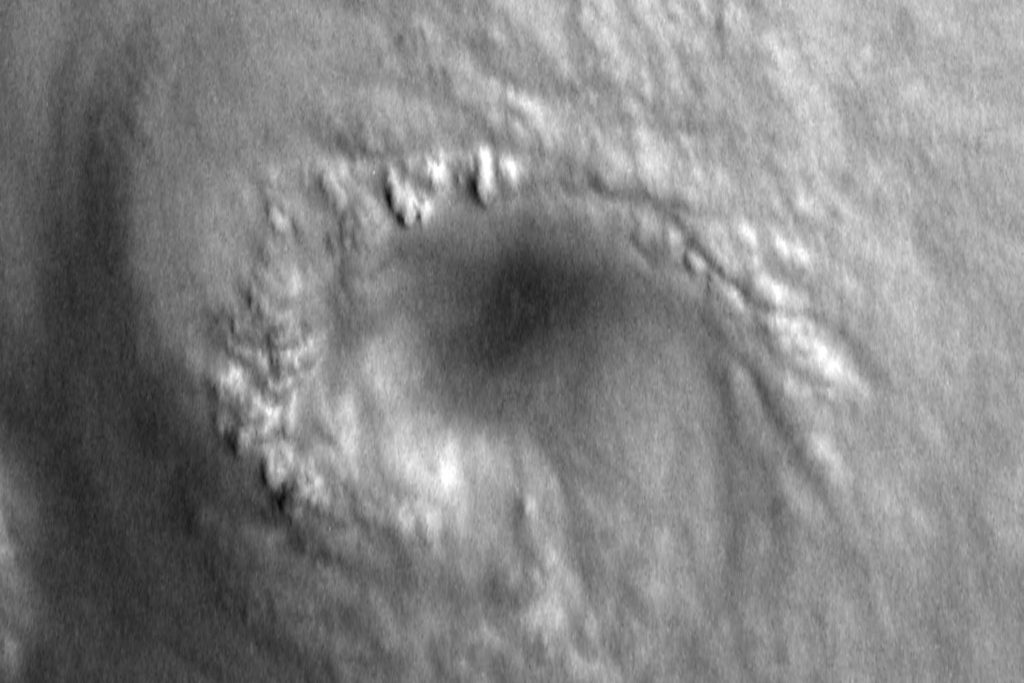
Related Reading
Drew LePage, “The Hurricane Hunter Satellites”, Drew Ex Machina, May 15, 2022 [Post]
Drew LePage, “Using the Carnot Engine Model to Characterize Hurricanes from Orbit”, TWA Blog, July 23, 2022 [Post]
Drew LePage, “Turn Up the Stereo”, TWA Blog, March 3, 2022 [Post]
Paul Joss, “The Cyclone Intensity Measurements from the ISS (CyMISS)”, Space Station Research Explorer [Page]
Bill Keeter, “ISS Daily Summary Report – 9/11/2017”, ISS On-Orbit Status Report, September 11, 2017 [Post]

